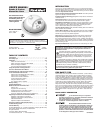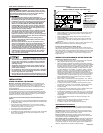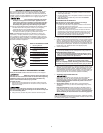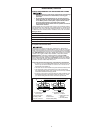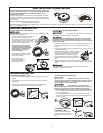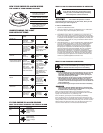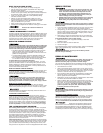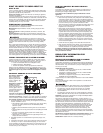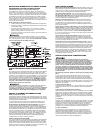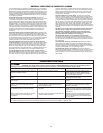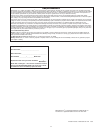
GENERAL LIMITATIONS OF SMOKE/CO ALARMS
This Smoke/CO Alarm is intended for residential use. It is not intended
for use in industrial applications wher
e Occupational Safety and Health
Administration (OSHA) r
equirements for Carbon Monoxide Alarms must
be met. The Smoke Alarm portion of this device is not intended to alert
hearing impair
ed residents. Special purpose Smoke Alarms should be
installed for hearing impair
ed residents (CO Alarms are not yet available
for the hearing impaired).
Smoke/CO Alarms may not waken all individuals. Practice the
escape plan at least twice a year
, making sure that everyone is involved
– fr
om kids to grandparents. Allow children to master fire escape
planning and practice before holding a fire drill at night when they are
sleeping. If childr
en or others do not readily waken to the sound of the
Smoke/CO Alarm, or if ther
e are infants or family members with mobility
limitations, make sure that someone is assigned to assist them in fire
drill and in the event of an emer
gency. It is recommended that you hold
a fir
e drill while family members are sleeping in order to determine their
response to the sound of the Smoke/CO Alarm while sleeping and
to determine whether they may need assistance in the event of an
emer
gency.
Smoke
/CO
Alar
ms cannot work without power.
Battery operated units
cannot work if the batteries are missing, disconnected or dead, if the wrong
type of batteries ar
e used, or if the batteries are not installed correctly.
AC units cannot work if the AC power is cut off for any reason (open fuse
or circuit breaker, failure along a power line or at a power station, electrical
fir
e that burns the electrical wires, etc.). If you are concerned about the
limitations of battery or AC power, install both types of units.
This Smoke/CO Alarm will not sense smoke or CO that does not
reach the sensors.
It will only sense smoke or CO at the sensor. Smoke
or CO may be pr
esent in other areas. Doors or other obstructions may
affect the rate at which CO or smoke reaches the sensors. If bedroom
doors are usually closed at night, we recommend you install an alarm
device (Combination CO and Smoke Alarm, or separate CO Alarms and
Smoke Alarms) in each bedroom and in the hallway between them.
This Smoke/CO Alarm may not sense smoke or CO on another
level of the home.
Example: This alarm device, installed on the second
floor, may not sense smoke or CO in the basement. For this r
eason,
one alarm device may not give adequate early warning. Recommended
minimum pr
otection is one alarm device in every sleeping area, every
bedr
oom, and on every level of your home. Some experts recommend
battery powered Smoke and CO Alarms be used in conjunction with
inter
connected AC powered Smoke Alarms. For details, see “About
Smoke Alarms” for details.
Smoke/CO Alar
ms may not be heard.
The alarm hor
n loudness
meets or exceeds current UL standards of 85 dB at 10 feet (3 meters).
However
, if the Smoke/CO Alarm is installed outside the bedroom, it
may not wake up a sound sleeper or one who has r
ecently used drugs
or has been drinking alcoholic beverages. This is especially true if the
door is closed or only partly open. Even persons who ar
e awake may
not hear the alarm hor
n if the sound is blocked by distance or closed
doors. Noise from traffic, stereo, radio, television, air conditioner, or
other appliances may also pr
event alert persons from hearing the alarm
hor
n. This Smoke/CO Alarm is not intended for people who are hearing
impaired.
The Alarm may not have time to alarm before the fire itself causes
damage, injur
y, or death, since smoke from some fires may not
reach the unit immediately. Examples of this include persons
smoking in bed, children playing with matches, or fires caused
by violent explosions r
esulting from escaping gas.
This Smoke/CO Alar
m is not a substitute for life insurance.
Though this Smoke/CO Alarm warns against increasing CO levels or
the presence of smoke, BRK Brands, Inc. does not warrant or imply in
any way that they will pr
otect lives. Homeowners and renters must still
insure their lives.
This Smoke/CO Alarm has a limited life. Although this Smoke/CO
Alarm and all of its parts have passed many stringent tests and are
designed to be as r
eliable as possible, any of these parts could fail at
any time. Therefore, you must test this device weekly. The unit should
be replaced immediately if it is not operating properly.
This Smoke/CO Alarm is not foolproof. Like all other electronic
devices, this Smoke/CO Alarm has limitations. It can only detect smoke
or CO that reaches the sensors. It may not give early warning of the
sour
ce of smoke or CO is in a remote part of the home, away from the
alarm device.
Once a minute, the alarm sounds 3 quick
“chirps”, and the green light flashes quickly
thr
ee times.
MALFUNCTION SIGNAL. Unit needs to be
replaced. Based on self-diagnostic tests, the
unit has detected a fault.
Units under warranty should be r
eturned to
manufacturer for replacement. See “Limited
W
arranty” for details.
Once a minute, the Green light flashes and the
horn “chirps”.
Low battery warning. Battery is low or missing. Replace the battery, avoid interrupting AC
power.
If your Alarm does this... It means... You should...
Green light is OFF. Unit will not alarm when you
press the Test/Silence button.
Unit may not be receiving any power.
Check the AC power supply. Make sure the
power connector is securely attached to the
alarm. Make sure a fresh 9V battery is installed
to power the battery back-up
*.
Green light flashes ON, once a minute (horn is
silent).
Alarm is not receiving AC power.
Unit is operating on battery back-up.
Check the AC power supply.
TROUBLESHOOTING GUIDE
Alarm goes back into alarm after you pressed
the T
est/Silence button to silence an alarm.
Smoke and/or CO levels are still potentially
danger
ous.
Refer to “If Your Smoke/CO Alarm Sounds” for
details on how to r
espond to an alarm. If anyone
is feeling ill, EVACUATE your home immediately
and call 911.
If you have any questions that cannot be answered by reading this manual, call Consumer Affairs: 1-800-323-9005.
*For a list of acceptable replacement batteries, see “Regular Maintenance.”
Alarm sounds frequently even though no high
levels of smoke or CO are revealed in an
investigation.
The Alarm may be improperly located. Refer to
“Where to Install This Alarm.”
Relocate your alarm. If frequent alarms continue,
have home rechecked for potential problems.
You may be experiencing an intermittent smoke
or CO problem.
ELECTRICAL SHOCK HAZARD. Turn off the power to the area where the Alarm is installed BEFORE removing it from the mounting bracket or
checking any electrical connections! Failure to turn off the power first may result in serious electrical shock, injury or death.
10



